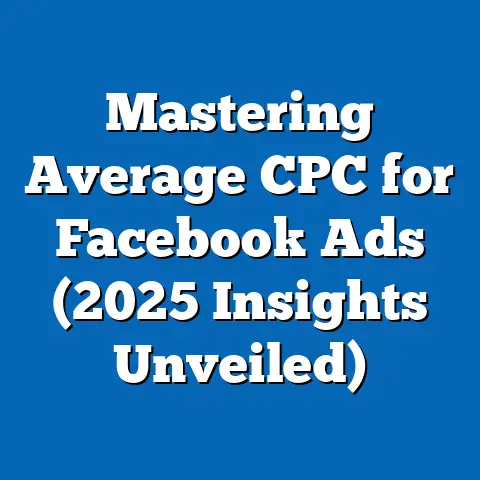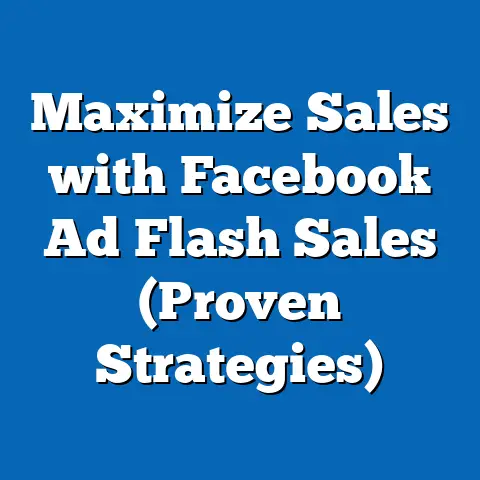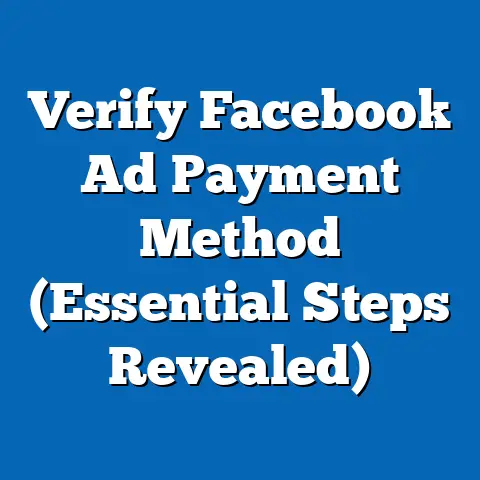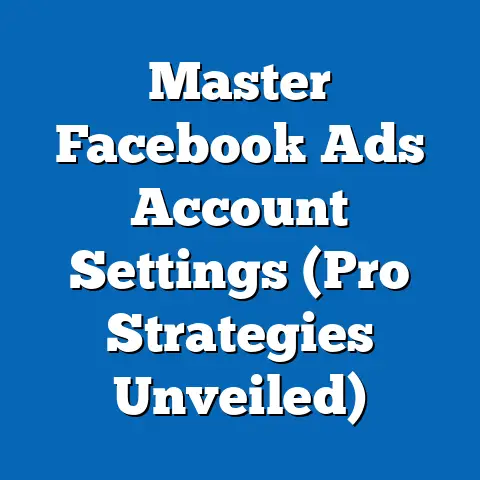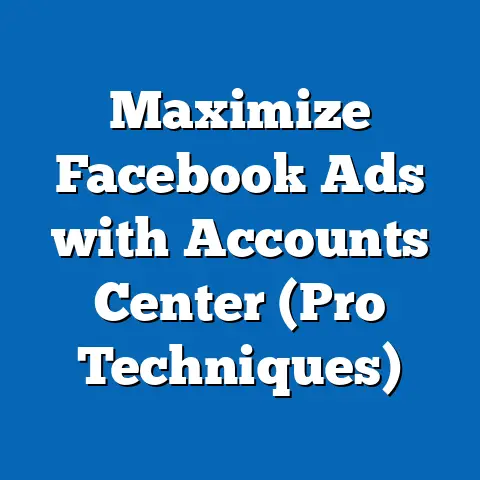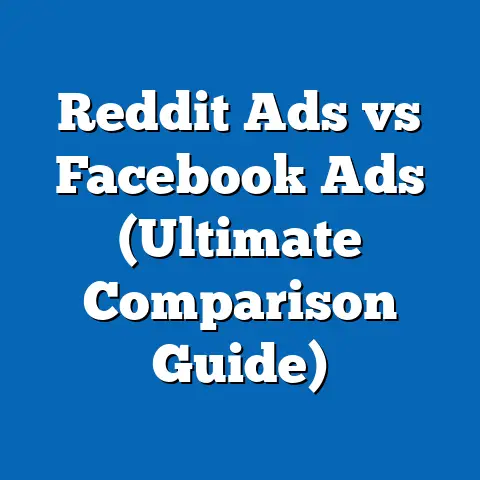Top Facebook Ads Strategies (Game-Changing Insights)
Facebook advertising remains one of the most powerful tools for businesses to reach targeted audiences, with over 2.9 billion monthly active users as of Q2 2023, according to Meta’s official reports. As the platform continues to dominate the digital advertising landscape, understanding the strategies that drive engagement and conversions is critical for marketers. This comprehensive article delves into the top Facebook Ads strategies, starting with the pivotal role of leveraging emotions, and explores data-driven insights, trends, and demographic patterns to help brands achieve game-changing results.
With ad spending on social media platforms projected to reach $219.8 billion globally by 2024 (Statista, 2023), businesses must optimize their campaigns to stand out in an increasingly competitive space. This article breaks down proven strategies, backed by statistics and case studies, to guide marketers in crafting impactful Facebook Ads. From emotional storytelling to advanced targeting techniques, let’s explore the approaches that are reshaping the advertising game.
Leveraging Emotions: The Heart of Effective Facebook Ads
Why Emotions Drive Engagement
Emotions are a cornerstone of human decision-making, and tapping into them can significantly boost the effectiveness of Facebook Ads. According to a 2016 study by the Harvard Business Review, emotionally engaging content is more likely to be shared, with 70% of viral content evoking strong feelings such as awe, anger, or amusement. On Facebook, where users scroll through personal and emotional content, ads that resonate on an emotional level can cut through the noise.
Consider the success of campaigns that evoke nostalgia or joy—think of holiday-themed ads or heartwarming family stories. These ads don’t just sell a product; they create a connection. A 2022 report by Nielsen found that ads with high emotional resonance had a 23% higher likelihood of driving purchase intent compared to purely informational ads.
Key Statistics on Emotional Advertising
- Emotional Impact on ROI: A study by Kantar (2021) revealed that campaigns with strong emotional storytelling on social media platforms like Facebook generated a 31% higher return on investment (ROI) than non-emotional campaigns.
- Shareability Factor: Emotionally charged ads are shared 2.5 times more frequently than neutral ads, according to a 2020 analysis by Unruly, a video ad tech company.
- Demographic Preferences: Younger audiences (18-34) are 40% more likely to engage with humorous or inspirational content, while older users (55+) respond better to ads evoking trust and security, per a 2022 Sprout Social report.
How to Leverage Emotions in Facebook Ads
To harness emotions effectively, start by identifying the core feelings associated with your brand or product. Are you selling a solution that brings relief (e.g., financial planning tools) or joy (e.g., family vacation packages)? Use storytelling to craft narratives that align with these emotions, incorporating visuals like videos or images that evoke the desired response.
For instance, a pet food brand might show a heartwarming reunion between a dog and its owner to highlight loyalty and love. Pair this with a compelling call-to-action (CTA) like “Show Your Pet You Care” to drive clicks. Testing different emotional angles through A/B testing can also help pinpoint what resonates most with your audience.
The Current State of Facebook Advertising: Trends and Data
Growth of Facebook Ads Spending
Facebook continues to be a dominant force in digital advertising, with ad revenue reaching $113.6 billion in 2022, as reported by Meta. This accounts for nearly 20% of the global digital ad market, according to eMarketer (2023). Small and medium-sized businesses (SMBs) are particularly active, with over 10 million advertisers using the platform as of 2023 (Meta Business Report).
Ad spending trends show a shift toward mobile-first strategies, as 98.5% of Facebook users access the platform via mobile devices (Statista, 2023). This underscores the importance of optimizing ads for smaller screens with quick-loading visuals and concise messaging.
Historical Trends vs. Current Data
Historically, Facebook Ads were primarily text-based or static image campaigns in the early 2010s, with limited targeting options. By 2015, video ads emerged as a key format, and today, they account for 54% of ad impressions on the platform (Socialbakers, 2022). Engagement rates for video ads are also 37% higher than static image ads, reflecting a clear trend toward dynamic content.
Another notable shift is the rise of Stories Ads. Introduced in 2018, Stories now reach over 500 million daily users, and ads in this format have a 20% lower cost-per-click (CPC) compared to News Feed ads (Hootsuite, 2023). This cost efficiency makes Stories an attractive option for budget-conscious marketers.
Demographic Patterns in Facebook Usage
Understanding who uses Facebook is crucial for targeting. As of 2023, the platform’s largest demographic is the 25-34 age group, making up 29.9% of users globally (Statista). However, older demographics are growing, with users aged 55+ increasing by 12% year-over-year, indicating a broadening audience base.
Gender distribution remains relatively balanced, with 56.3% male and 43.7% female users. Geographically, India leads with 314 million users, followed by the United States (179 million) and Indonesia (119 million), per DataReportal (2023). These demographic insights highlight the need for localized and age-specific ad strategies to maximize relevance.
Top Facebook Ads Strategies for Game-Changing Results
1. Advanced Audience Targeting with Lookalike Audiences
Facebook’s Lookalike Audiences allow advertisers to reach new users who share similar characteristics with their existing customers. By uploading a customer list or using pixel data, businesses can target users with comparable behaviors and interests. According to a 2021 study by WordStream, campaigns using Lookalike Audiences saw a 30% higher conversion rate compared to broad targeting.
Implementation Tip: Start with a high-value seed audience, such as past purchasers or email subscribers, to ensure the algorithm identifies quality matches. Test different audience sizes (1%-5% similarity) to balance reach and precision.
Demographic Focus: Lookalike Audiences work particularly well for younger demographics (18-34), who are 25% more likely to engage with personalized ads (Sprout Social, 2022).
2. Dynamic Ads for Personalized Experiences
Dynamic Ads automatically tailor content to individual users based on their browsing history or interactions. For e-commerce brands, these ads can showcase products a user viewed but didn’t purchase, driving re-engagement. A 2022 report by Criteo found that Dynamic Ads on Facebook have a 45% higher click-through rate (CTR) than static retargeting ads.
Data Visualization Description: Imagine a bar chart comparing CTRs across ad formats, with Dynamic Ads towering at 2.5%, compared to 1.7% for static retargeting and 1.2% for generic display ads. This visual would underscore the effectiveness of personalization.
3. Video Ads with Emotional Storytelling
As mentioned earlier, video ads dominate engagement metrics on Facebook. Short-form videos (15-30 seconds) perform best, with 80% of users watching at least half of such content (HubSpot, 2023). Combining video with emotional storytelling can amplify results—think of a charity ad showing real stories of impact to inspire donations.
Methodology Insight: Use Facebook’s built-in analytics to track video completion rates and adjust content length or messaging based on drop-off points. For example, if users stop watching at 10 seconds, ensure your key message appears earlier.
Case Study: A 2021 campaign by Dove used a 20-second video highlighting self-esteem stories, achieving a 50% increase in ad recall and a 35% boost in brand favorability (Meta Case Studies).
4. Carousel Ads for Multi-Product Showcase
Carousel Ads allow brands to display multiple images or videos in a single ad unit, ideal for showcasing product ranges or storytelling sequences. These ads have a 30-50% lower cost-per-conversion compared to single-image ads, per a 2022 AdEspresso analysis. Retail and fashion brands see particularly strong results, with engagement rates 20% higher than other industries (Socialbakers, 2023).
Demographic Insight: Millennials (25-34) are 28% more likely to interact with Carousel Ads, often swiping through to explore options (Statista, 2022).
Practical Tip: Use a mix of product shots and lifestyle images in Carousels to balance utility and inspiration, and include a clear CTA on the final card.
5. Stories Ads for Immersive Engagement
Stories Ads leverage the full-screen, vertical format to capture attention, especially among mobile users. With over 500 million daily Stories viewers, this format offers high visibility at a lower CPC, as noted earlier. A 2023 study by Mobile Marketer found that Stories Ads drive 18% more purchases among Gen Z users compared to News Feed ads.
Trend Analysis: Stories Ads usage has grown by 40% since 2020, reflecting a shift toward ephemeral, authentic content (eMarketer, 2023).
Best Practice: Use interactive elements like polls or swipe-up links in Stories Ads to boost engagement, and keep visuals bold and text minimal for quick impact.
Challenges and Pitfalls to Avoid in Facebook Ads
Ad Fatigue and Declining Engagement
Ad fatigue occurs when users see the same ad repeatedly, leading to lower engagement. A 2022 study by Social Media Today found that 38% of users stop interacting with ads after seeing them more than five times. To combat this, rotate creative assets weekly and use frequency capping in Facebook Ads Manager to limit impressions per user.
Privacy Concerns and Data Restrictions
With Apple’s iOS 14.5 update in 2021 and increasing privacy regulations, tracking capabilities have diminished, impacting ad targeting precision. Meta reported a $10 billion revenue loss in 2022 due to these changes (CNN Business, 2022). Marketers must adapt by focusing on first-party data, such as email lists, and leveraging on-platform tools like Conversions API for better attribution.
High Competition and Rising Costs
CPC on Facebook has risen by 17% year-over-year as of 2023, averaging $0.97 globally (WordStream). Industries like finance and insurance face even higher costs, with CPCs exceeding $3. To manage budgets, prioritize high-ROI formats like Stories and Dynamic Ads, and target niche audiences to reduce competition.
Broader Implications and Future Trends
The landscape of Facebook advertising is evolving rapidly, driven by technological advancements and changing user behaviors. The integration of artificial intelligence (AI) in ad creation and optimization is set to redefine strategies, with Meta’s AI tools already improving ad delivery efficiency by 32% for select advertisers (Meta Blog, 2023). Additionally, the rise of augmented reality (AR) ads offers immersive experiences, particularly for younger demographics, with 60% of Gen Z users expressing interest in AR try-on features (Snapchat Insights, 2022).
Demographically, the aging user base suggests that brands targeting older audiences will find increasing opportunities on Facebook, necessitating content that prioritizes trust and reliability. Meanwhile, the platform’s expansion in emerging markets like India and Africa points to the importance of localized campaigns that respect cultural nuances.
Looking ahead, marketers must balance creativity with data-driven decisions to stay competitive. Emotional storytelling will remain a powerful tool, but its success depends on authentic connections rather than manipulative tactics. As privacy concerns grow, building trust with transparent data practices will be non-negotiable.
In conclusion, mastering Facebook Ads requires a blend of emotional resonance, precise targeting, and adaptability to trends. By leveraging the strategies outlined—Lookalike Audiences, Dynamic Ads, video storytelling, Carousels, and Stories—brands can unlock game-changing results. With ad spending and competition set to rise, the time to refine your approach is now, ensuring your campaigns not only reach but resonate with the right audience.

